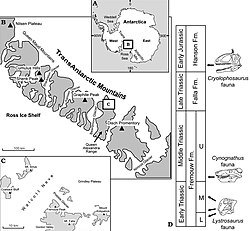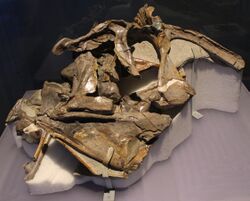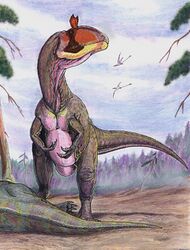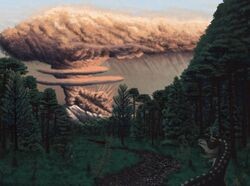Biology:Cryolophosaurus
| Cryolophosaurus | |
|---|---|

| |
| Reconstructed skeleton, Field Museum of Natural History | |
| Scientific classification | |
| Domain: | Eukaryota |
| Kingdom: | Animalia |
| Phylum: | Chordata |
| Clade: | Dinosauria |
| Clade: | Saurischia |
| Clade: | Eusaurischia |
| Clade: | Theropoda |
| Clade: | Neotheropoda |
| Genus: | †Cryolophosaurus Hammer & Hickerson, 1994 |
| Type species | |
| †Cryolophosaurus ellioti Hammer & Hickerson, 1994
| |
Cryolophosaurus (/ˌkraɪəˌloʊfəˈsɔːrəs/ or /kraɪˌɒləfəˈsɔːrəs/; KRY-ə-LOH-fə-SAWR-əs) is a genus of large theropod dinosaur known from only a single species Cryolophosaurus ellioti, from the early Jurassic of Antarctica. It was one of the largest theropods of the Early Jurassic, with the subadult being estimated to have reached 6–7 metres (20–23 ft) long and weighed 350–465 kilograms (772–1,025 lb).
Cryolophosaurus was first excavated from Antarctica's Early Jurassic, Pliensbachian aged Hanson Formation, formerly the upper Falla Formation, by paleontologist Dr. William Hammer in 1991. It was the first carnivorous dinosaur to be discovered in Antarctica and the first non-avian dinosaur from the continent to be officially named. The sediments in which its fossils were found have been dated at ~196 to 188 million years ago, representing the Early Jurassic Period.
Cryolophosaurus is known from a skull, a femur and other material, all of which have caused its classification to vary greatly. The femur possesses many primitive characteristics that have classified Cryolophosaurus as a dilophosaurid or a neotheropod outside of Dilophosauridae and Averostra, whereas the skull has many advanced features, leading the genus to be considered a tetanuran, an abelisaurid, a ceratosaur and even an allosaurid.[2][3] Cryolophosaurus is currently considered to be a derived neotheropod, close to Averostra. Additionally, Cryolophosaurus possessed a distinctive "pompadour" crest that spanned the head from side to side. Based on evidence from related species and studies of bone texture, it is thought that this bizarre crest was used for intra-species recognition. The brain of Cryolophosaurus was also more primitive than those of other theropods.
Discovery and naming
Cryolophosaurus originally was collected during the 1990–91 austral summer on Mount Kirkpatrick in the Beardmore Glacier region of the Transantarctic Mountains. The discovery was made by Hammer, a professor at Augustana College, and his team. The fossils were found in the siliceous siltstone of the Hanson Formation, formerly the upper Falla Formation, and dated to the Pliensbachian Stage of the early Jurassic. Cryolophosaurus was the second dinosaur, and first theropod, to be discovered in Antarctica. It was discovered after Antarctopelta, but named earlier.[4]
In 1991, both Hammer and the Ohio State University geologist David Elliot excavated separate outcrops near Beardmore Glacier, sharing logistical expenses. Elliot's team first came across the remains of Cryolophosaurus in a rock formation around the altitude of 4,000 m (13,000 ft) high and about 640 km (400 mi) from the South Pole. When the discovery was made, they soon notified Hammer. Over the next three weeks, Hammer excavated 2,300 kg (5,100 lb) of fossil-bearing rock. The team recovered over 100 fossil bones, including those of Cryolophosaurus.[4] The specimens were formally named and described in 1994 by Hammer and Hickerson, in the journal Science.[4]
During the 2003 season, a field team returned and collected more material from the original site. A second locality was discovered about 30 metres (98 ft) higher in the section on Mt. Kirkpatrick.[5]
The name Cryolophosaurus ellioti is derived from the Greek words κρυος (meaning 'cold' or 'frozen', in reference to its discovery in Antarctica), λοφος (meaning 'crest') and σαυρος (meaning 'lizard'), thus "cold crest lizard". Hammer and Hickerson named the species C. ellioti, after David Elliot, who had made the initial discovery of the fossils.[4]
Description
Cryolophosaurus was a large, well-built theropod, one of the largest of its time. The holotype specimen is estimated to have reached 6–7 m (20–23 ft) long and weighed 350–465 kg (772–1,025 lb).[6][7][8] In 2016 Molina-Pérez and Larramendi gave a larger estimation of 7.7 meters (25.3 ft) and 780 kg (1,720 lb).[9] Some researchers noted that the holotype individual probably represents a sub-adult, so adults could have been larger.[7][10] Despite having slender proportions, Cryolophosaurus is one of the largest known Early Jurassic theropods.[10][11]
The holotype FMNH PR1821 is the only fully described specimen of Cryolophosaurus. The specimen consists of an incomplete skull and mandibles lacking most of their front half; nine maxillary teeth; a fragmentary sixth cervical centrum; cervical vertebrae 7–10; several posterior cervical ribs; several anterior dorsal vertebrae; most mid and posterior dorsal vertebrae; several dorsal ribs; the fifth sacral vertebrae; three chevrons; many partial and complete caudal vertebrae and centra; two partial humeri; a proximal radius; a proximal ulna; a partial ilium; a proximal pubis; both ischia, but only one distal; two incomplete femora; the distal end of a tibia; the distal end of a fibula, and the astragalus and calcaneum.[7] In 2013, new material of Cryolophosaurus was unearthed in Antarctica. The description of this material has not yet been published in a non-abstract form.[12]
Skull
The holotype of Cryolophosaurus consists of a high, narrow skull, which was discovered articulated with the rest of the skeleton.[6] The skull is an estimated 65 centimetres (26 in) long. It has a peculiar nasal crest that runs just over the eyes, where it rises perpendicular to the skull and fans out. It is thin and highly furrowed, giving it a unique "pompadour" appearance and earned it the nickname "Elvisaurus."[13] The crest is an extension of the skull bones, near the tear ducts, fused on either side to orbital horns which rise from the eye sockets. While other theropods like the Monolophosaurus have crests, they usually run along the skull instead of across it.[14]
An unpublished study conducted by Vernon Meidlinger-Chin in 2013 suggested that previous studies lacked focus on endocranial details. The study found that the Cryolophosaurus fossil has a nearly complete, undistorted cranial cavity which is complete enough to give an approximate shape and size of the living brain. The endocast features clarified the dissimilarity of the skull with those of Allosauroids and Coelurosaurs giving Cryolophosaurus a basal position in Theropoda.[11] Closer examination of how the skull bones fused reviewed details in the snout and forehead that are exceptionally similar to Dilophosaurus.[15]
Classification
Classification of Cryolophosaurus is difficult because it has a mix of primitive and advanced characteristics.[16] The femur has traits of early theropods, while the skull resembles much later species of the clade Tetanurae, like China's Sinraptor and Yangchuanosaurus. This led Paul Sereno et al. (1994) to place Cryolophosaurus in the taxon Allosauridae.[17] Originally, Hammer and colleagues suspected that Cryolophosaurus might be a ceratosaur or even an early abelisaur, with some traits convergent with those of more advanced tetanurans, but ultimately concluded that it was itself the earliest known member of the tetanuran group.[4] While a subsequent study by Hammer (along with Smith and Currie) again recovered Cryolophosaurus as a tetanuran, a later (2007) study by the same authors found that it was more closely related to Dilophosaurus and Dracovenator.[14][18] Sterling Nesbitt et al. (2009), using the characters of Tawa found Cryolophosaurus to be neither a dilophosaurid nor averostran neotheropod but instead the sister group of a clade composed of dilophosaurids and averostrans.[19] However, in 2012, Matthew Carrano found that Cryolophosaurus was a tetanuran, related to Sinosaurus, but unrelated to Dilophosaurus.[20] In 2020, a monograph of Dilophosaurus found Cryolophosaurus to be a derived neotheropod, close to Averostra, in a more derived position than Zupaysaurus, but less than Dilophosaurus.[21]
The following cladogram illustrates a synthesis of the relationships of the early theropod groups compiled by Hendrickx et al. in 2015.[22]
| Neotheropoda |
| |||||||||||||||||||||||||||||||||||||||||||||||||||||||||
However, a 2020, a study conducted Adam Marsh and Timothy Rowe found Cryolophosaurus to be a basal Neotheropod. While it was still closer to Averostra than Coelophysoidea was, it was still more basal than Dilophosaurus.[23]
| Neotheropoda |
| ||||||||||||||||||||||||||||||||||||||||||||||||||||||||||||
Paleobiology
Cranial ornamentation
Cranial display features, such as the one possessed by Cryolophosaurus, make sense in social, gregarious animals, where other members of the species are available to observe and interpret messages of sexual status.[24] Kevin Padian et al. (2004) challenged conventional hypotheses that the purpose of bizarre cranial structures and post-cranial armor in dinosaurs, was either for attracting mates, intimidating/fighting rivals in the group, or intimidating potential predators of other species. Padian et al. noted that based on phylogenetic, histological, and functional evidence these bizarre structures can be explained by the phenomenon of intra-species recognition, which is supported by the fossil evidence.[25][26] Thomas R. Holtz Jr. (2010) found that the bizarre crest of Cryolophosaurus was primarily for intra-species recognition, based on evidence from related species and studies of bone texture.[27] According to Thomas Rich and his colleagues, the crest would have been ineffective as a weapon and may have possibly functioned as a display feature during certain types of social behavior such as mating.[28] In 2019, a species recognition function was disputed but a socio-sexual display structure model was suggested.[29]
Diet
When the type specimen was discovered, several long cervical ribs, of a supposed prosauropod dinosaur were found in the mouth of Cryolophosaurus, which led Hammer (1998) to conclude that it was feeding on the prosauropod when it died. Hammer further noted that since the ribs were found extending all the way back to the theropod's neck region, this individual may have choked to death on these ribs.[6] However, Smith et al. concluded that these remains belonged to the Cryolophosaurus specimen itself, and not to Hammer's "prosauropod".[18] Hammer also concluded that a post-canine tooth belonging to a tritylodont (an early mammal relative), found with the remains, was part of its stomach contents when it died.[30]
Paleopathology
Some Cryolophosaurus bones have pathologies that show evidence of scavenging. Broken teeth from a juvenile Cryolophosaurus were found nearby.[28] These teeth have no roots and likely shed naturally while scavenging the adult Cryolophosaurus carcass.
Another possible pathology is found in the astragalus (ankle bone) of Cryolophosaurus. This bone was preserved with a small splint from the fibula located just above the ankle. The splint, however, may also be just a unique morphological feature of Cryolophosaurus.[7]
Paleoenvironment
All known specimens of Cryolophosaurus have been recovered in the Hanson Formation, which is one of only two major dinosaur-bearing rock formations found on the continent of Antarctica. Cryolophosaurus was found about 650 kilometres (400 mi) from the South Pole but,[6] at the time it lived, this was about 1,000 km (621 mi) or so farther north.[31] The Hanson Formation accumulated in a rift environment located between c. 60 and 70S, fringing the East Antarctic Craton behind the active Panthalassan margin of southern Gondwana, being dominated by two types of facies: "tuffaceous" siltstone of fluvial and volcanic strata, deposited maybe more than 10 million years based on the thickness.[32] In the Early Jurassic, Antarctica was closer to the equator and the world was considerably warmer than today, but the climate was still cool temperate similar to that of modern southern Chile , and humid, with a temperature interval of 17–18 degrees. Models of Jurassic air flow indicate that coastal areas probably never dropped much below freezing, although more extreme conditions existed inland.[33]
This formation has produced the remains of two smaller theropods, the sauropodomorph Glacialisaurus,[34] a crow-sized pterosaur (a dimorphodontid), a tritylodont, herbivorous synapsid, and two small unnamed sauropodomorphs.[35][36] Beyond vertebrates, Insects (Blattodea, Coleoptera), Ostracodans, Conchostracans and arthropod ichnofossils (Diplichnites, Planolites, Scoyenia) are know from other coeval localities, like Gair Mesa, Mount Carson or Shafer Peak.[37] Plant remains are also very common, from large tree trunks (+50 cm) at Mount Carson to Palynomorphs at Shafer Peak.[38] Macrofoliar and cuticle remains have also been recovered from seveal localities, including Conifers (Araucariaceae, Cheirolepidiaceae, Cupressaceae, Pinaceae or Voltziales), Cycadophytes (Bennettitales), Pteridosperms (Corystospermaceae), Ferns (Dipteridaceae, Matoniaceae, Osmundaceae and Polypodiales), Equisetaceae, Isoetaceae and Liverworts (Marchantiales).[39] Some of the plant remains are relictual genera, like the youngest record of Dicroidium.[40] Common presence of the invertebrate ichnogenus Planolites indicates the local fluvial, alluvial or lacustrine waters where likely continuous all year, as well the presence of abundant Otozamites trends to suggest high humidity.[39] Overall points to a setting with strong seasonality in day-length given the high latitude, perhaps similar to warm-temperate, frost-free forest and open woodland as in North Island of New Zealand. Despite the proper conditions, peat accumulation was rare, mostly due to the influence of local volcanism, with common wildfire activity as shown by charred coalified plant remains.[39]
References
- ↑ Bomfleur, B.; Schöner, R.; Schneider, J. W.; Viereck, L.; Kerp, H.; McKellar, J. L. (2014). "From the Transantarctic Basin to the Ferrar Large Igneous Province—new palynostratigraphic age constraints for Triassic–Jurassic sedimentation and magmatism in East Antarctica". Review of Palaeobotany and Palynology 207 (1): 18–37. doi:10.1016/j.revpalbo.2014.04.002. Bibcode: 2014RPaPa.207...18B. https://www.sciencedirect.com/science/article/pii/S0034666714000529. Retrieved 20 February 2022.
- ↑ Evans, D.C.; Vavrek, M.J. (2012). Ultimate Dinosaurs: Giants from Gondwana. Toronto:Royal Ontario Museum. pp. 30–1.
- ↑ Pickrell, John (2004). "Two New Dinosaurs Discovered in Antarctica". National Geographic. http://news.nationalgeographic.com/news/2004/03/0309_040309_polardinos.html.
- ↑ 4.0 4.1 4.2 4.3 4.4 Hammer, W. R.; Hickerson, W. J. (1994). "A Crested Theropod Dinosaur from Antarctica". Science 264 (5160): 828–830. doi:10.1126/science.264.5160.828. PMID 17794724. Bibcode: 1994Sci...264..828H.
- ↑ Leslie, M (2007). "The Strange Lives of Polar Dinosaurs". Smithsonian Magazine. http://www.smithsonianmag.com/history-archaeology/polar-dinosaurs-200712.html?c=y&page=3. Retrieved 2008-01-24.
- ↑ 6.0 6.1 6.2 6.3 Hammer, W.R.; Hickerson, W.J. (1999). Tomida, Y.. ed. "Gondwana Dinosaurs from the Jurassic of Antarctica". Proceedings of the Second Gondwana Dinosaur Symposium National Science Museum Monographs. 15: 211–217.
- ↑ 7.0 7.1 7.2 7.3 Smith, N.D.; Makovicky, P.J.; Hammer, W.R.; Currie, P.J. (2007). "Osteology of Cryolophosaurus ellioti (Dinosauria: Theropoda) from the Early Jurassic of Antarctica and implications for early theropod evolution". Zoological Journal of the Linnean Society 151 (2): 377–421. doi:10.1111/j.1096-3642.2007.00325.x. https://01182bb5-a-62cb3a1a-s-sites.googlegroups.com/site/cryolophosaurus1/home/osteologyofcryolophosaurus.pdf?attachauth=ANoY7co94mntSd_9o3eefP85wHz2ynfTQvKhMQNAdIZyoumnStLJlkuCFE6wOc78UXxEzyKf7eoh5B7Q_gchrMoiEymFA2HDiwUdKgZfTtI7rBSvtQcOw59po7bxBLJS6npKics2ZiBxPl5gLrb5tE_fgjwFL2uNYd3-w49KLuHDvIcdirdJPAgh21lcdc77_OvOah6HbJGj-am2pnY0ofNNa_6y6ZBdpxt038pM6yuR7sppHUj-KaMxH0r11XJR8VwNGPRkdNFe&attredirects=0.[yes|permanent dead link|dead link}}]
- ↑ Paul, Gregory S. (2010). "Theropods". The Princeton Field Guide to Dinosaurs. Princeton: Princeton University Press. pp. 67–162. doi:10.1515/9781400836154.67b. ISBN 9781400836154.
- ↑ Molina-Pérez & Larramendi (2016). Récords y curiosidades de los dinosaurios Terópodos y otros dinosauromorfos. Barcelona, Spain: Larousse. pp. 254.
- ↑ 10.0 10.1 Benson, R.; Brusatte, S.; Hone, D.; Naish, D.; Xu, X.; Anderson, J.; Clack, J.; Duffin, C. et al. (2012). Ambrose, Jamie; Gilpin, David; Hirani, Salima et al.. eds. Prehistoric Life: A Definitive Visual History of Life on Earth. Dorling Kindersley. pp. 1–512. ISBN 978-0-7566-9910-9. OCLC 444710202.
- ↑ 11.0 11.1 Meidlinger-Chin, V. (2013). "Braincase and Endocranial anatomy of Cryolophosaurus ellioti (Dinosauria: Theropoda) from the Early Jurassic of Antarctica". Geological Society of America Abstracts with Programs 45 (4): 65. http://gsa.confex.com/gsa/2013NC/webprogram/Paper218390.html.
- ↑ Smith, N.D.; Hammer, W.R.; Makovicky, P.J. (2013). "New Dinosaurs from the Early Jurassic Hanson Formation of Antarctica, and Patterns of Diversity and Biogeography in Early Jurassic Sauropodomorphs". Geological Society of America Abstracts with Programs: 405–406. http://gsa.confex.com/gsa/2013AM/finalprogram/abstract_232923.htm. Retrieved 2013-12-20.
- ↑ swigodner (2017-08-02). "Antarctic Dinosaurs" (in en). https://www.fieldmuseum.org/at-the-field/exhibitions/antarctic-dinosaurs.
- ↑ 14.0 14.1 Smith, N. D.; Hammer, W.R.; Currie, P.J. (2005). "Osteology and phylogenetic relationships of Cryolophosaurus ellioti (Dinosauria: Theropoda): Implications for basal theropod evolution". Journal of Vertebrate Paleontology 25 (3): 116A–117A. doi:10.1080/02724634.2005.10009942.
- ↑ "VERTEBRAL ANATOMY OF CRYOLOPHOSAURUS ELLIOTI, A THEROPOD DINOSAUR FROM THE EARLY JURASSIC OF ANTARCTICA". https://gsa.confex.com/gsa/2012NC/finalprogram/abstract_202648.htm.
- ↑ Holtz, T.R. Jr.; Molnar, R.E.; Currie, P.J. (2004). "Basal Tetanurae". in Weishampel, D.B.; Dodson, P.; Osmólska, H.. The Dinosauria (Second ed.). University of California Press. pp. 71–110. ISBN 978-0-520-24209-8.
- ↑ Sereno, P.C.; Wilson, J.A.; Larsson, H.C.E.; Dutheil, D.B.; Sues, H-D. (1994). "Early Cretaceous dinosaurs from the Sahara". Science 266 (5183): 267–270. doi:10.1126/science.266.5183.267. PMID 17771449. Bibcode: 1994Sci...266..267S.
- ↑ 18.0 18.1 Smith, N. D.; Makovicky, P.J.; Pol, D.; Hammer, W.R.; Currie, P.J. (2007). "The Dinosaurs of the Early Jurassic Hanson Formation of the Central Transantarctic Mountains: Phylogenetic Review and Synthesis". US Geological Survey Open-File Report 2007 (1047srp003). doi:10.3133/of2007-1047.srp003.
- ↑ Nesbitt, S.J.; Smith, N.D.; Irmis, R.B.; Turner, A.H.; Downs, A.; Norell, M.A. (2009). "A complete skeleton of a Late Triassic saurischian and the early evolution of dinosaurs". Science 326 (5959): 1530–1533. doi:10.1126/science.1180350. PMID 20007898. Bibcode: 2009Sci...326.1530N.
- ↑ Carrano, M. T.; Benson, R. B. J.; Sampson, S. D. (2012). "The phylogeny of Tetanurae (Dinosauria: Theropoda)". Journal of Systematic Palaeontology 10 (2): 211–300. doi:10.1080/14772019.2011.630927.
- ↑ Marsh, Adam D.; Rowe, Timothy B. (July 2020). "A comprehensive anatomical and phylogenetic evaluation of Dilophosaurus wetherilli (Dinosauria, Theropoda) with descriptions of new specimens from the Kayenta Formation of northern Arizona" (in en). Journal of Paleontology 94 (S78): 1–103. doi:10.1017/jpa.2020.14. ISSN 0022-3360. Bibcode: 2020JPal...94S...1M.
- ↑ Hendrickx, C.; Hartman, S.A.; Mateus, O. (2015). "An Overview of Non- Avian Theropod Discoveries and Classification". PalArch's Journal of Vertebrate Palaeontology 12 (1): 1–73.
- ↑ Marsh, Adam D.; Rowe, Timothy B. (July 2020). "A comprehensive anatomical and phylogenetic evaluation of Dilophosaurus wetherilli (Dinosauria, Theropoda) with descriptions of new specimens from the Kayenta Formation of northern Arizona" (in en). Journal of Paleontology 94 (S78): 1–103. doi:10.1017/jpa.2020.14. ISSN 0022-3360. Bibcode: 2020JPal...94S...1M.
- ↑ Dodson, P. (1997). "Paleoecology". in Currie, P.J.; Padian, K.. Encyclopedia of Dinosaurs. Academic Press. ISBN 978-0-12-226810-6.
- ↑ Glut, D.F. (2006). Dinosaurs, the Encyclopedia, Supplement 4. McFarland & Company, Inc. p. 749. ISBN 978-0-7864-2295-1.
- ↑ Padian, K.; Horner, J.R.; Dhaliwal, J. (2004). "Species recognition as the principal cause of bizarre structures in dinosaurs". Journal of Vertebrate Paleontology 23 (3 Suppl): 100A. doi:10.1080/02724634.2003.10010538.
- ↑ Holtz, T.R. Jr. (2012). Dinosaurs: The Most Complete, Up-to-Date Encyclopedia for Dinosaur Lovers of All Ages. Random House Books for Young Readers. pp. 90–91. ISBN 978-0-375-82419-7. https://archive.org/details/dinosaursmostcom00holt/page/90.
- ↑ 28.0 28.1 Rich, T.R.; Gangloff, R.A.; Hammer, W.R. (1997). "Polar dinosaurs". in Currie, P.J.; Padian, K.. Encyclopedia of Dinosaurs. Academic Press. pp. 562–573. ISBN 978-0-12-226810-6.
- ↑ Chan-gyu, Yun. (2019). "An enigmatic theropod Cryolophosaurus: Reviews and Comments on its paleobiology". Volumina Jurassica 17: 1–8.
- ↑ Glut, D.F. (1999). Dinosaurs, the Encyclopedia, Supplement 1. McFarland & Company, Inc. p. 442. ISBN 978-0-7864-0591-6.
- ↑ Dodson, P. (1997). "Distribution and Diversity". in Currie, P.J.; Padian, K.. Encyclopedia of Dinosaurs. Academic Press. pp. 10–13. ISBN 978-0-12-226810-6.
- ↑ Elliot, D. H.; Larsen, D.; Fanning, C. M.; Fleming, T. H.; Vervoort, J. D. (2017). "The Lower Jurassic Hanson Formation of the Transantarctic Mountains: implications for the Antarctic sector of the Gondwana plate margin". Geological Magazine 154 (4): 777–803. doi:10.1017/S0016756816000388. Bibcode: 2017GeoM..154..777E. https://www.cambridge.org/core/services/aop-cambridge-core/content/view/0ED8AE6AEF7D7888C2AE577F641663C0/S0016756816000388a.pdf/the-lower-jurassic-hanson-formation-of-the-transantarctic-mountains-implications-for-the-antarctic-sector-of-the-gondwana-plate-margin.pdf. Retrieved 7 March 2022.
- ↑ Chandler, M. A.; Rind, D.; Ruedy, R. (1992). "Pangaean climate during the Early Jurassic: GCM simulations and the sedimentary record of paleoclimate". Geological Society of America Bulletin 104 (1): 543–559. doi:10.1130/0016-7606(1992)104<0543:PCDTEJ>2.3.CO;2. Bibcode: 1992GSAB..104..543C. https://pubs.giss.nasa.gov/abs/ch07200r.html.
- ↑ Smith, Nathan D.; Pol, Diego (2007). "Anatomy of a basal sauropodomorph dinosaur from the Early Jurassic Hanson Formation of Antarctica". Acta Palaeontologica Polonica 52 (4): 657–674. http://app.pan.pl/acta52/app52-657.pdf.[yes|permanent dead link|dead link}}]
- ↑ Hammer, W.R.; Hickerson, W.J.; Slaughter, R.W. (1994). "A dinosaur assemblage from the Transantarctic Mountains". Antarctic Journal of the United States 29 (5): 31–32. https://s3.amazonaws.com/Antarctica/AJUS/AJUSvXXIXn5/AJUSvXXIXn5p31.pdf.
- ↑ Smith, Nathan D. (2013). "New Dinosaurs from the Early Jurassic Hanson Formation of Antarctica, and Patters of Diversity and Biogeography in Early Jurassic Sauropodomorphs.". Geological Society of America Abstracts with Programs 45 (7): 897.
- ↑ Bomfleur, B.; Schneider, J. W.; Schöner, R.; Viereck-Götte, L.; Kerp, H. (2011). "Fossil sites in the continental Victoria and Ferrar groups (Triassic-Jurassic) of north Victoria Land, Antarctica". Polarforschung 80 (2): 88–99. https://www.researchgate.net/publication/234143783. Retrieved 15 November 2021.
- ↑ Musumeci, G.; Pertusati, P. C.; Ribecai, C.; Meccheri, M. (2006). "Early Jurassic fossiliferous black shales in the Exposure Hill Formation, Ferrar Group of northern Victoria Land, Antarctica". Terra Antartica Reports 12 (1): 91–98. https://www.researchgate.net/publication/286878347. Retrieved 17 November 2021.
- ↑ 39.0 39.1 39.2 Bomfleur, B.; Pott, C.; Kerp, H. (2011). "Plant assemblages from the Shafer Peak Formation (Lower Jurassic), north Victoria Land, Transantarctic Mountains". Antarctic Science 23 (2): 188–208. doi:10.1017/S0954102010000866. Bibcode: 2011AntSc..23..188B. https://www.researchgate.net/publication/230040881.
- ↑ Bomfleur, B.; Blomenkemper, P.; Kerp, H.; McLoughlin, S. (2018). "Polar regions of the Mesozoic–Paleogene greenhouse world as refugia for relict plant groups". Transformative Paleobotany 15 (1): 593–611. doi:10.1016/B978-0-12-813012-4.00024-3. https://www.diva-portal.org/smash/get/diva2:1257996/FULLTEXT01.pdf. Retrieved 13 February 2022.
External links
- Transantarctic Vertebrate Paleontology Project, official website for the NSF project conducting research on Cryolophosaurus and related fauna (photos, research information, publication list, geology, project members ...)
- Fryxell Geology Museum (photos, information)
- Field Museum of Natural History (video, information)
Wikidata ☰ Q131166 entry
 |










